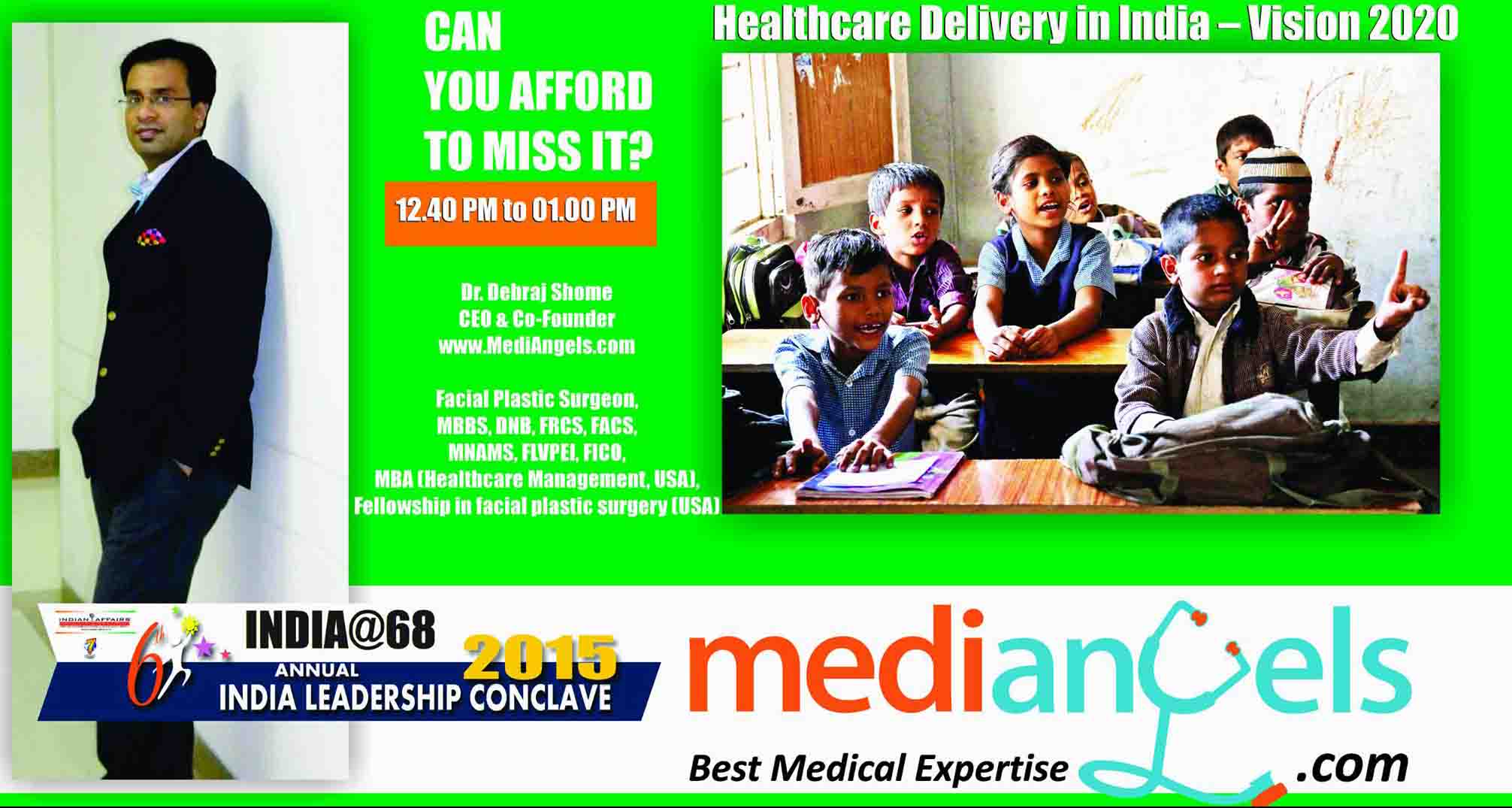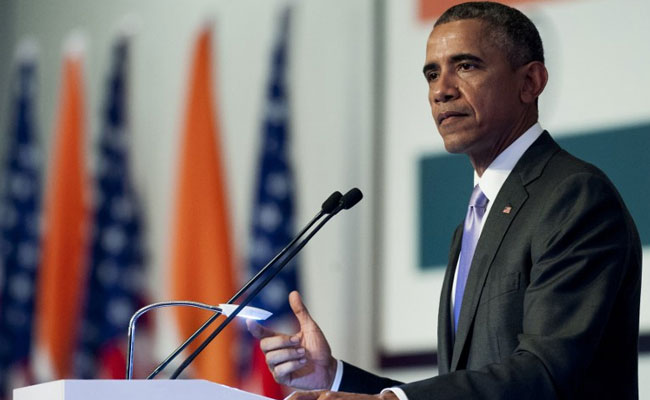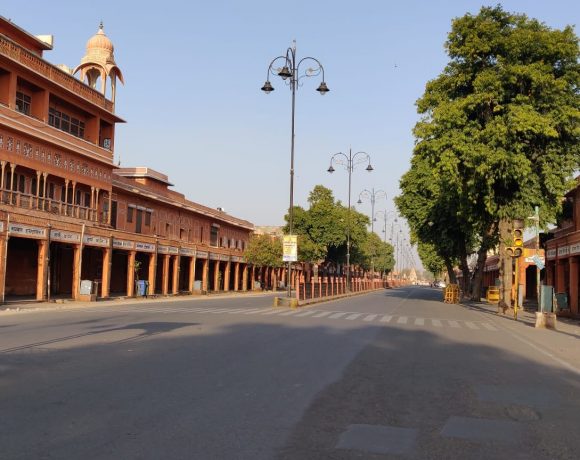

Facial Plastic Surgeon & Healthcare Economist Dr. Debraj Shome to address Healthcare Delivery in India – Vision 2020 at India Leadership Conclave 2015
India Needs Flexible Healthcare Reforms to boost India’s pride in Global Healthcare Map. Free medicines cannot fix an overburdened public healthcare system in which many hospitals lack up-to-date equipment and doctors. Thus, the free essential drugs scheme is just one of the many steps the government will need to take to ensure universal healthcare. I feel the adoption at the national level of an e-healthcare system like the one followed in Tamil Nadu can help to provide free medicines to those who need them in a transparent and efficient manner.
@emediangels Founder @debrajshome to address on Healthcare Delivery in India @#IndiaLeadershipConclave2015 pic.twitter.com/r2uJvCHRN3
— Indian Affairs (@Indian_Affairs) September 15, 2015
India is a fertile ground for entrepreneurs, given its large pool of world-class talent and resources. India’s ability to generate wealth and create social good will come if we let entrepreneurs flourish by encouraging and enabling innovation. Innovation and biotechnology can transform our numerous challenges – healthcare, education, development, agriculture, environment, and energy among others – into opportunities by developing innovative products that can benefit millions and drive economic growth.
However, unlike in the West where capital markets are willing to invest in innovation for a long term, innovation in India is viewed as high-risk, low gain option and hence not investor-friendly. Investors in India are not prepared to invest in capital intensive long-term innovation based business models. India, therefore, needs a robust innovation “ecosystem.” The government needs to establish strong industry-academia linkages to foster the spirit of enterprise and drive employment. However, a national innovation ecosystem is not enough, because if innovation is to flourish, ideas have to be funded to bring them to the market. As a traditionally risk-averse nation, India has rarely been at the forefront of innovation. Indian companies have mostly imitated others and became very good at it. Even in the biotech sector, most companies operate in the low-risk services and generic diagnostics, vaccines and therapeutics space.
It is time for biotechnology companies, especially in India and other developing countries, to re-orient their efforts to aggressively harness innovation through partnerships and collaborations to attain the dream of ensuring healthcare for all. The government also needs to be an enabler by putting in place policies that will create a robust innovation “ecosystem” in India. Today, the Indian government has abdicated its responsibility to provide basic healthcare to its people, but it’s holding a gun at the pharma industry and asking it to shoulder the burden. The industry has worked very hard to create a cost-effective and competitive sector. It is actually producing the cheapest drugs in the world, but on top of that the government is dictating how much profit the pharma industry is allowed to make. A complete lack of political will and effective administration have kept accessible and affordable healthcare out of the reach of most Indians.
The lack of a universal healthcare system in our country compels patients to bear almost 80% of the healthcare costs directly from their pocket. The opportunity therefore lies in leveraging India’s value advantage and scientific excellence to come up with innovative technology for offering world-class products at affordable prices, thus making a huge difference to millions of patients in India.
India has a fast-growing economy as well as an ever-expanding, ever-urbanized population, however its healthcare system still has a lot of potential for development. India’s drug industry to touch $48 billion by 2018 Industry may see growth on back of patent expiry of some blockbuster drugs in US and local demand. India’s drugs and pharmaceuticals industry is likely to post total sales of Rs.2.91 trillion ($47.88 billion) by 2018, with an average yearly growth of at least 14%, aided by a rapidly growing domestic market and the newly emerging export opportunity as patents of at least a dozen blockbuster drugs in the US expire in the next three years. “During 2014-2016, about $92 billion worth patented drugs are expected to go off patent in the US as compared with $65 billion during 2010-12, as per the research study by Pharmaleaders.
Pharmaleaders agree that India’s pharmaceutical sector will touch close to US$ 55 billion by 2020 & the Indian pharmaceutical market will be the sixth largest in the world by 2020.The rise of pharmaceutical outsourcing and investments by multinational companies (MNCs), allied with the country’s growing economy, committed health insurance segment and improved healthcare facilities, is expected to drive the market’s growth. India is today one of the top emerging markets in the global pharmaceutical scene. The sector is highly knowledge-based and its steady growth is positively affecting the Indian economy. The organised nature of the Indian pharmaceutical industry is attracting several companies that are finding it viable to increase their operations in the country.From a market size of US$ 12.6 billion in 2009, the Indian pharmaceutical market will grow to US$ 55 billion by 2020, with the potential to reach US$ 70 billion in an aggressive growth scenario. In a pessimistic scenario characterised by regulatory controls and economic slowdown, the market will be depressed but is still expected to reach US$ 35 billion.India currently exports drug intermediates, Active Pharmaceutical Ingredients (APIs), Finished Dosage Formulations (FDFs), Bio-Pharmaceuticals, and Clinical Services across the globe. The exports of pharmaceuticals from India grew to US$ 14.6 billion in 2012-13 from US$ 6.23 billion in 2006-07, registering a compound annual growth rate (CAGR) of around 15.2 per cent.The allowance of foreign direct investment (FDI) in India’s pharma sector has been well received by foreign investors. According to data released by the Department of Industrial Policy and Promotion (DIPP), the drugs and pharmaceutical sector attracted FDI worth Rs 60,100.91 crore (US$ 9.94 billion) between April 2000 and June 2014.
A year ago, newly elected Indian Prime Minister Narendra Modi was promising to do big things, including amend a law that made it unreasonably difficult for companies to acquire land for factories and infrastructure projects. He’s more or less given up on that particular ambition, after stumbling into fierce resistance in the opposition-dominated upper house of Parliament.
The comedown arrives just as GDP growth slowed to 7 percent in the second quarter, disappointing those hoping India would shoot past a faltering China to become the world’s fastest-growing major economy.
Modi needs to change this souring narrative, and fast. Individual states might still be able to push forward much-needed reforms in land and labor. But at the national level, the opposition has succeeded in painting Modi’s agenda as pro-business and anti-poor. That’s a precarious place for the prime minister to be, especially with politically crucial elections coming up in largely agrarian Bihar state.
Part of the problem is that Modi, despite his fabled skill as a communicator, has failed to explain to poorer Indians how reform will benefit them in addition to well-connected tycoons. He might have better luck if he sets aside the most controversial issues for now and focuses instead on sectors — among them, education and health care — that affect the masses more directly.
Radical reform is required in these areas as well. As a 2014 McKinsey report noted, half of public spending on basic services in India never reaches ordinary citizens. While primary and secondary education is free, the quality of public schools is atrocious: Over 90 percent of Indian children are enrolled in primary school, but that number drops to 36 percent by the time kids reach the upper secondary level. Similarly, access to health care is poor. India has only one doctor for every 1,700 people — well below the World Health Organization recommendation of one for every 1,000. At 66 years, India’s life expectancy ranks the country at 139 among 194 nations, lower than nations like Bangladesh and Indonesia.
As McKinsey notes, there’s no dearth of good ideas for how to improve outcomes for students and patients. The focus on providing free public health care has stretched resources too thin. A better strategy, suggested last week by the government’s own think tank, NITI Aayog, would be to shift to an insurance-based system. Citizens would all contribute to a “Sickness Fund” and then be reimbursed for care, regardless of whether they visited a public or private hospital. Modi’s government proposed a similar system for life and accident insurance last year, allowing the poor to access benefits for a nominal premium. The government could provide vouchers to aid the very poorest.
A voucher system would also help schoolchildren. Government schools suffer not just from a lack of funding, but from weak teachers. A World Bank study found that 25 percent of teachers didn’t show up to school and only half were actually teaching classes. Giving parents the freedom to choose schools — whether public or private — would encourage competition and hopefully improve quality at state schools.
Importantly, one of the government’s central successes thus far has been to build the foundations for such reforms, which require transferring cash directly to patients and parents. Over the last year, the government has opened 175 million new accounts for citizens. The Aadhar system of unique identity cards, launched under the previous government, now covers 870 million people. Officials can be reasonably confident that they can target cash vouchers to deserving recipients without money being skimmed off by middlemen. The cost to the government would be far less than trying to revamp the public education and health care systems from scratch.
Even poor Indians have shown they’re willing to pay for private-sector clinics and schools, despite sometimes steep expenses. Rather than fighting this trend, the government should clear away the red tape which prevents new facilities from being built. That would bring costs down, while direct aid would help the poorest afford fees.
These might seem like radical ideas to some in India. That’s the point: Reform doesn’t only mean making life easier for industrialists. Such changes would have an immediate impact on the lives of the poor, even while creating efficiencies throughout the economy. Modi could begin right away by launching pilot programs in states controlled by his Bharatiya Janata Party, which might allow him to post a few quick wins. At this point, he has little to lose.
Healthcare landscape in India has many challenges starting with access to specialist care in rural areas, skewed doctor–patient ratios, long wait times and finally when your turn comes in, very little doctor time available for a consultation compared to other countries worldwide (thanks to busy doctors and scarcity of specialists). And in the middle of these delivery challenges is the alarming increase in non-communicable diseases or NCD’s. It is estimated that roughly 40% of the adult population already has a chronic condition (asthma, diabetes, hypertension, osteoarthritis) or at significant risk of developing the condition due to family history, eating and sedentary habits, pollution and air quality.
Mobile and internet technology that can be applied to healthcare like the cloud services, wearable devices, internet of things (IOT) has offered tremendous opportunities to solve and mitigate some of the challenges impacting healthcare delivery in India.
We can broadly look at four areas where healthcare transformation is happening and that holds more potential for the future – Improve Healthcare Access, Improvements to Care Delivery, Distribution of healthcare service and Health Management tools and technologies. Improve Access: Imagine the impact when every mobile becomes a tele-health device that can make doctor consultations and follow-ups happen from any place. Effective tele-health via mobile opens up more doctor slots (Consultations at home, early mornings or late evenings or even in transit) and make it possible to access specialist doctors from tier-2 and 3 cities and towns. Appointments and follow-throughs are streamlined with appointment slot booking and updates happening real time with information available to doctors and patients.
Care Delivery: Access to diagnostic reports and data digitally improves quality of care and contributes to data collections that can be used for clinical research. For example in the case of post-discharge, Care management supplements doctor notes and inputs – It reduces pressure and time involved for doctors to repeat information and instructions that can be made available through technology with reminders and rich media like exercise videos and diet/nutrition charts.
Distribution: Services delivered from the comfort of home saves time and fixes inefficiencies and mark-ups involved in distribution channels. For example, automation in distribution of medicines from the time of prescription to door delivery will be faster and cheaper.
Health Management: Online communities and support groups for doctors and patients bring together people with similar interests to collaborate and improve quality of care and diagnosis. This offers some of the best hope to manage the risks of chronic and lifestyle conditions.
This transformation is in different stages today depending on your provider – doctor, hospital or the locations you live in. But every major healthcare group to smaller hospitals have started forays in these areas. Apollo Hospitals group has made it possible to access health records online and has launched new generation of tele-medicine services. Care Hospital group is offering a whole host of convenience and efficiencies through their patient portal and mobile. A large charity based hospital like Rangadore Memorial Hospital (RMH) offers Care Management for all mobile users (smart phones as well as via text messages).
The transformation has begun and as we look out there is will more standardization of these services with greater adoption. Technology innovation holds the best chance to impact and solve some of the healthcare challenges we face.


















